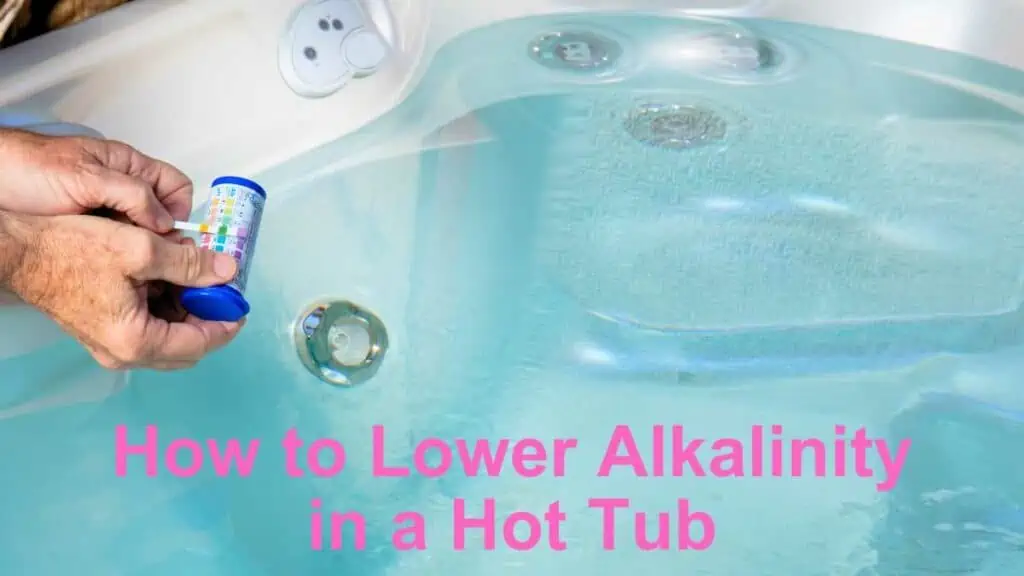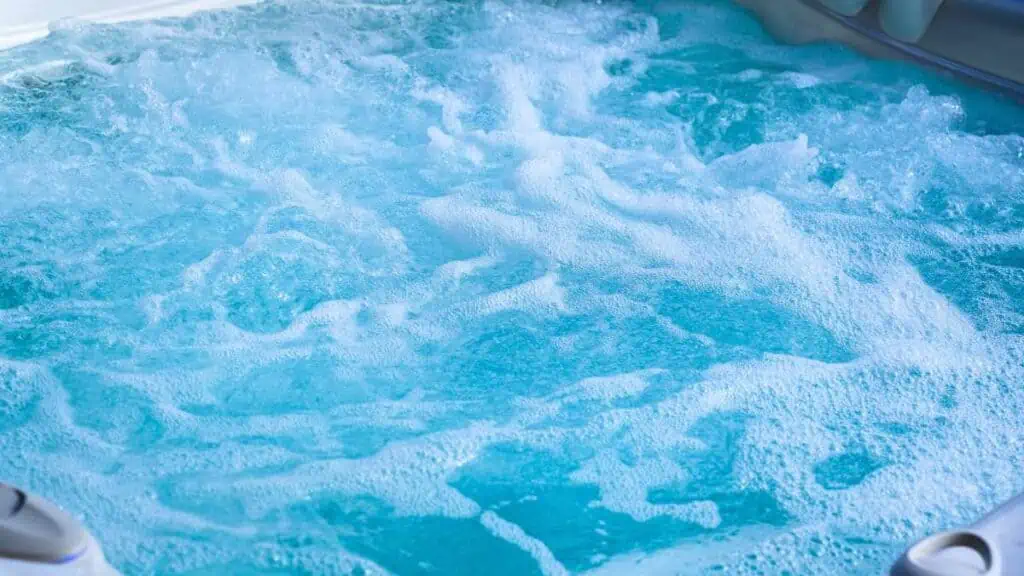Struggling with high alkalinity in your hot tub? You’re not alone! Maintaining the perfect chemical balance in a hot tub is crucial for both its longevity and your comfort. High alkalinity can lead to many problems, such as cloudy water, scale formation, and even damage to the hot tub equipment.
Balancing alkalinity saves time and effort and ensures a delightful hot tub experience. So, how do you tackle this common issue effectively? Well, we’ll be going over:
- What are the risks of high alkalinity in hot tubs and how can it affect your hot tub’s health?
- What are the best methods to lower alkalinity in your hot tub, ensuring a balanced and enjoyable experience?
- How can regular maintenance and testing prevent alkalinity issues and prolong the life of your hot tub?
Mastering the art of alkalinity management in hot tubs can transform your spa experience from problematic to perfect.

Key Takeaways
- Properly managing alkalinity is essential for maintaining a healthy hot tub environment
- High alkalinity can cause problems, such as cloudy water and can damage your hot tub
- Lowering alkalinity involves using chemicals like sodium bisulfate and muriatic acid and maintaining proper hot tub water care
How to Lower Your Hot Tub’s Alkalinity
This section will discuss various methods to use when you need to lower the alkalinity in your hot tub. The primary focus will be on using pH decreaser and muriatic acid.
Using pH Decreaser
A pH decreaser is one of the most common and effective ways to lower the alkalinity in your hot tub. These products generally contain sodium bisulphate, which works to neutralise alkalinity. Follow these simple steps for using pH reducer:
- Test the water: Use chemical test strips to measure the alkalinity level. The ideal range for your hot tub is between 80 and 120 parts per million (ppm).
- Determine the dosage: Consult the product label to determine the appropriate amount of pH reducer based on the current alkalinity reading.
- Add the decreaser: Dissolve it in a bucket of water, then slowly pour it into the hot tub, distributing it evenly across the surface.
- Wait and retest: Allow the water to circulate for a few hours, then test the alkalinity again.
I recommend SpaGuard pH Decreaser, which is available on Amazon.
The Role of Muriatic Acid
Muriatic acid can also decrease alkalinity, though it is a more potent and potentially hazardous option. Care must be taken when handling muriatic acid, and it should be used in a well-ventilated area. The steps to use muriatic acid are similar to those of using a pH reducer:
- Test the water: Use chemical test strips to measure the alkalinity level.
- Determine the dosage: Consult the product label or seek professional advice to determine the appropriate amount of muriatic acid based on the current alkalinity reading.
- Add the acid: Slowly pour the muriatic acid into the hot tub, distributing it evenly across the surface.
- Wait and retest: Allow the water to circulate for a few hours, then test the alkalinity level again.
Understanding Alkalinity in a Hot Tub
The Importance of Alkalinity and pH Balance
Maintaining the proper water chemistry in your hot tub is essential for your equipment’s longevity and comfort. A key aspect of this process is checking and managing water alkalinity levels.
Alkalinity refers to the capacity of water to neutralise acids, acting as a pH buffer. In simpler terms, it helps maintain a stable pH level in your hot tub water.
Alkalinity is measured in parts per million (ppm). The ideal range is between 80 and 120 parts per million (ppm) and a reading of between 7.2 and 7.8 on the pH scale. These levels are essential for the following reasons:
- Preventing Corrosion: Low alkalinity can cause your hot tub components to corrode due to acidic water.
- Avoiding Scale Formation: High alkalinity can lead to scale formation on the hot tub surfaces and equipment.
- Comfort: Balanced the alkalinity and the pH levels ensure a comfortable spa experience for you and your guests, preventing eye and skin irritation.
How to Test Total Alkalinity in a Hot Tub?
Regularly testing the hot tub water is crucial to maintain ideal alkalinity levels. To test the water, follow these steps:
- Acquire a Test Kit: Purchase a test kit that measures alkalinity and the pH levels. These kits are available in various formats, such as test strips or liquid reagent kits.
- Collect a Water Sample: Draw a water sample from your hot tub, making sure to collect water from the middle depth of the tub.
- Perform the Test: Follow the instructions provided with your test kit to perform the alkalinity and pH tests. Take note of the results.
- Make Adjustments: If the test results indicate that the alkalinity or pH levels are outside their ideal ranges, add appropriate chemicals to your hot tub water.
Recommended Test Strips
What Happens if Hot Tub Water Alkalinity Is Too High?
Why Does Proper Alkalinity Level Matter?
High alkalinity in a hot tub can cause various issues that negatively impact water quality. One common issue is that it can make the water cloudy, directly resulting from increased alkalinity.
High pH levels allow minerals and other particles to mix into the water, creating cloudiness. This can make it difficult for you to see the bottom of the tub and may be aesthetically unpleasant.
Another problem that may occur due to higher alkalinity is green water. This can potentially indicate the presence of algae, which can thrive in high-pH environments. In addition to unsightly discolouration, algae can clog your hot tub filters and affect the overall efficiency of your system.
Identifying Alkalinity-Related Problems
To determine whether there are issues related to high alkalinity in a spa, it’s important to test your water’s pH and alkalinity levels regularly. Here are some common signs that the alkalinity is high in your hot tub:
- Cloudy water: As mentioned earlier, increased mineral content can cause the water to become cloudy.
- Scaling: High alkalinity may lead to scale formation on your hot tub’s equipment and surfaces. This can not only harm the appearance of your tub but also reduce the efficiency of your system.
- Reduced sanitizer effectiveness: High alkalinity can make your hot tub’s sanitizer less effective, decreasing water quality and potential health risks.
Acids for Lowering High Alkalinity
You can use several acids to lower the alkalinity in your hot tub. Each acid has advantages and disadvantages, so it’s essential to understand the most suitable for your situation.
Muriatic Acid (Hydrochloric Acid): This is the most common and widely used acid for lowering alkalinity levels in hot tubs. It’s a strong, effective, and fast-acting solution. When handling muriatic acid, always take proper safety precautions, such as wearing protective gloves and eyewear, and dilute the acid in water before adding it to your hot tub.
Sodium Bisulfate (Dry Acid): Sodium bisulfate is another popular option for reducing alkalinity in hot tubs. It’s a less hazardous alternative to muriatic acid but also less potent. Sodium bisulfate comes in a granular form, which makes it easier to handle and control. Dissolve the appropriate amount of sodium bisulfate in water before adding it to the hot tub.
Sulfuric Acid: Although not commonly used in residential hot tubs, sulfuric acid is a potent and effective option for lowering alkalinity. It’s essential to exercise extreme caution when handling sulfuric acid, as it’s highly corrosive and can cause severe burns if it comes into contact with your skin.
Calcium Hypochlorite: Calcium hypochlorite is a granular compound primarily used as a sanitizer and shock for hot tub water. However, it also has a pH-lowering effect and can be used in small amounts to adjust alkalinity levels. The overuse of calcium hypochlorite can lead to calcium buildup and cloudy water.
Note: Baking Soda and Soda Ash will increase the alkalinity, not lower the ta.
How to Lower Alkalinity in a Hot Tub Without Lowering pH
- Test the Water: Determine the current total alkalinity (TA) and pH levels. Ideal TA levels are typically between 80-120 ppm (parts per million), and ideal pH levels are 7.2-7.8.
- Use a pH Decreaser: To lower alkalinity, add pH decreaser. Sodium bisulfate (dry acid) or muriatic acid (hydrochloric acid) is commonly used. It’s important to note that these chemicals lower alkalinity and temporarily lower pH.
- Apply the Chemical Gradually: Ideally, add the pH decreaser to some water in a container first, then, when it has dissolved, pour it into the hot tub evenly. Doing this slowly and in small increments is crucial, allowing the water to circulate after each addition. This gradual approach helps minimize the impact on pH levels.
- Circulate the Water: Turn on the hot tub jets to thoroughly mix the chemicals in the water. Circulation is key to distribute the pH decreaser evenly.
- Retest the Water: After allowing the water to circulate for a couple of hours, retest the alkalinity and pH levels. If the alkalinity is still high, repeat the process of adding more pH decreaser in small amounts.
- Adjust the pH if Necessary: If the pH has dropped significantly below the ideal range, you may need to bring it back up. To increase pH without significantly altering alkalinity, use a pH increaser like sodium carbonate (soda ash). Again, add this chemical gradually and retest the water until the desired pH level is achieved.
- Regular Maintenance: Regular testing and adjusting your hot tub’s water chemistry are essential for maintaining the ideal balance between pH and alkalinity.

Hot Tub Maintenance Tips for Owners
Regular Testing and Adjustment
As a hot tub owner, it’s essential to test your water and make adjustments when necessary regularly. This helps maintain a clean and comfortable environment for you to enjoy. Keeping your hot tub balanced is crucial for your health and the tub itself, but it’ll also save you time and money in the long run.
- Monitor pH levels: The ideal pH range for a hot tub is between 7.2 and 7.8. Testing and adjusting the pH will prevent issues related to high alkalinity.
- Check total alkalinity: Aim for a range of 80-120 parts per million (ppm) for optimal performance and water quality.
- Assess sanitizer levels: Chlorine and bromine are commonly used to keep the water free from bacteria and algae.
Here’s a sample weekly testing schedule for your hot tub:
| Day | Test | Adjustments |
| Monday | pH | pH Increaser/Decreaser |
| Wednesday | Total Alkalinity | Alkalinity Increaser |
| Friday | Sanitiser | Chlorine/Bromine Tablets |
Ensuring Long-Term Alkalinity Control
To maintain the proper alkalinity levels in your hot tub, it’s important to consider both short-term and long-term control methods:
- Short-term adjustments: Use a pH decreaser or sodium bisulfate to lower high alkalinity levels. Make changes in small amounts and test frequently to avoid overcorrection.
- Long-term control: Regularly cleaning and replacing your hot tub’s filters and using a quality water clarifier can help maintain consistency in the water’s alkalinity. Additionally, consider using non-chemical methods for adjusting alkalinity, such as diluting the water in the tub.
By staying on top of your hot tub care and making regular adjustments, you can keep your hot tub clean and balanced and ready for use whenever you want to relax.
Hot Tub Maintenance Course
I bought Swim University’s Hot Tub Maintenance Course a while after I bought my first hot tub and struggled to maintain it. It was very well spent and has paid for itself many times over the years as I have saved by not needing to use as many chemicals as I did previously.
Listen to our Hot Tub Course Review Podcast:









Leave a Reply